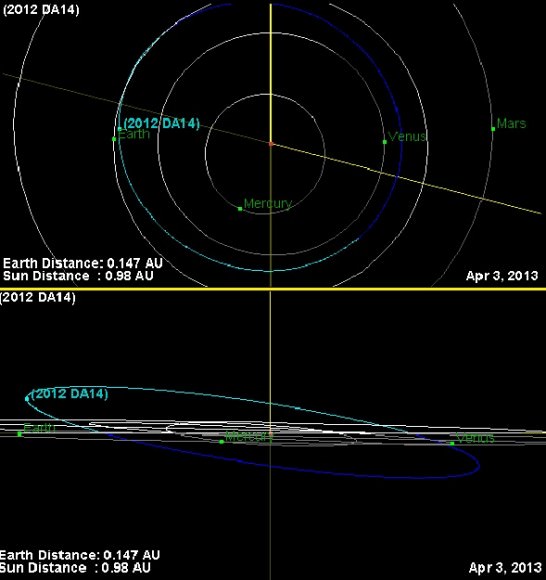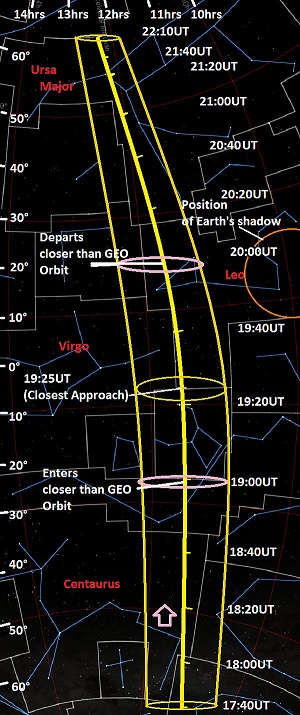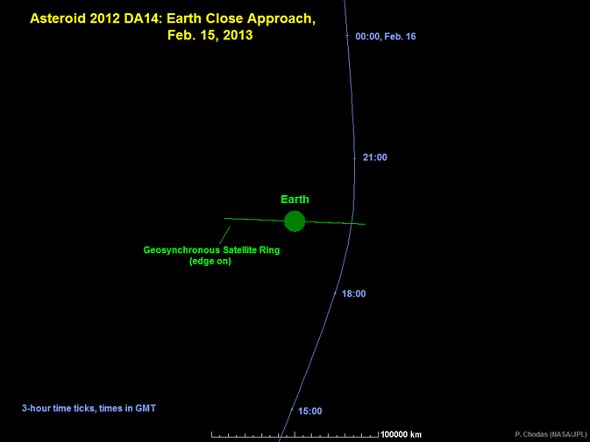Mark your calendars: this Friday, February 15, 2013, is the close flyby of Near Earth Asteroid 2012 DA14, passing just 27,630 kilometers (17,168 miles) from the surface of the Earth. About 50 meters (164 feet) in size, 2012 DA14 and its close shave marks the the first time there has been passage of an asteroid this close that we’ve known a year beforehand. Yes, it passes within the ring of geosynchronous satellites girdling the Earth. No, there’s no danger, either to said satellites or the Earth, so Bruce Willis can stay home for this one. But right behind those inquiries, the question we most frequently get is… how can I see it?

The great news is that an advanced observer can indeed catch 2012 DA14 on its close pass the night of February 15th… with a little skill and luck. Now for the bad news; the asteroid won’t be visible without binoculars or a telescope, and North America will largely miss out.
2012 DA14 will be really moving across the sky on closest approach, covering 0.8° per minute, or the diameter of a Full Moon every 45 seconds! With its passage closer to the Earth than the ring of geosynchronous satellites, it’s worth treating the passage of the asteroid as a satellite and hunting it down accordingly. Catching and watching such a pass can be an unforgettable experience; not many objects in the sky show such swift motion in real time. In fact, 2012 DA14 will span the celestial sphere from declination -60° to +60° in just 4 hours! Needless to say, its passage through the Earth’s gravity well will alter its orbit considerably; most planetarium software programs do not account for this and thus will introduce a large error for a heliocentric object. Compounding the dilemma is the large amount of parallactic shift of such a nearby object. As viewed from the span of the Earth, 2012 DA14 will have a parallax of ~20° at greatest approach!

But two sites on the web can help you with the search. One is Heavens-Above, which currently has a link on its main page to custom generate sky charts for specific locations for 2012 DA14 (make sure you’re logged in as a registered user and your observing location is set correctly). Another option is to generate an ephemeris customized for your location from the JPL Solar System Dynamics Horizons Web-Interface.
Asteroid 2012 DA14 is approaching the planet Earth from “down under,” and moving almost exactly parallel to the 12 hour line in right ascension. In fact, it’ll cross very near the equinoctial point in Virgo (one of the two points where the celestial equator and the ecliptic cross) shortly after its closest approach on Friday, February 15th at 19:25UT. The asteroid will be at the local zenith (straight overhead) for observers in the pre-dawn hours located in western Indonesia at closest approach. Australia and eastern Asia will have a shot at seeing the asteroid as it whizzes through the sky in the early morning hours of February 16th local. Observers in western Asia, Africa and Europe will see the asteroid lower to the east on the night of the 15th. Note that 2012 DA14 juuuuuust misses Earth’s shadow (see strip chart) at closest approach. The shadow of our fair planet is ~20° across at the distance of the geosynchronous satellites; had it passed about a month later, we would have seen an “asteroid eclipse!” In fact, “eclipse season” for geosynchronous satellites occurs right around the equinoxes and is only a month away.
The “banana strip chart” shows the path of 2012 DA14 from the time it reaches a magnitude brighter than +10 at 17:40UT until it dips back down below it at 22:10UT on the same night. It also shows the width of uncertainty for its position due to the aforementioned 20° of parallax, and the points that it enters and departs the distance sphere of the geosynchronous satellites. Keep in mind, these satellites still orbit roughly hundred times higher than the International Space Station!
A good search strategy to catch 2012 DA14 is to actually to treat it like you’re hunting for a faint satellite. Find the time that it’s crossing a set declination and begin scanning with binoculars in right ascension back and forth until you “ambush” your astronomical prey moving slowly against the starry background. If using a telescope, use the lowest power and widest field of view that the instrument will allow. We’ve used this technique in the past to sweep up Near Earth Asteroids 2005 YU55 and 99942 Apophis and routinely use it to hunt for satellites fainter than naked eye visibility. At closest approach, asteroid 2012 DA14 will shine at around +8th magnitude as it crosses the Bowl of Virgo northward past Denebola in the constellation Leo.
Recent measurements early this month conducted by astronomers at the Las Campanas observatory in Chile refined the orbit of 2012 DA14, placing its February 15th passage just 45 kilometres closer to Earth than previously calculated but still well outside the threat zone. Campaigns are underway to refine measurements of its orbit even further on this pass. We won’t get another close pass of 2012 DA14 until February 16th, 2046 when the asteroid misses us at about twice the distance of the Moon. An impact has been ruled out for this century. Predictions get less certain the further you project them into time, and 2012 DA14 will definitely be a space rock worth keeping tabs on!

